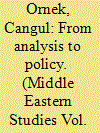| Srl | Item |
| 1 |
ID:
115332


|
|
|
|
|
| Publication |
2012.
|
| Summary/Abstract |
Turkish area studies in the US developed in parallel with the diplomatic rapprochement between Turkey and the US after the Second World War. This article scrutinizes the relation between Turkish studies and American public diplomacy in Turkey with special emphasis on the latter. Unlike cultural programmes in Europe, which focused on satisfying intellectuals' taste for high culture, in Turkey the concentration of the cultural activities was on bureaucrats, educators and technical personnel. The article argues that this was because of a modernization approach and the priority given to the needs of US aid programmes. Following the revolutions in Asia, the programme was further oriented to strengthen the collaboration between Americans and the technocratic elites of Turkey.
|
|
|
|
|
|
|
|
|
|
|
|
|
|
|
|
| 2 |
ID:
080639


|
|
|
|
|
| Publication |
2008.
|
| Summary/Abstract |
Ringvereine were officially chartered associations of ex-convicts which, on paper, provided mutual aid and promoted the cultural activities of their members. In reality, they promoted their members' criminal activities in various ways and acted as professional associations of criminals, which set and enforced rules and provided members with contacts, assistance and status. At least in certain areas, namely prostitution and racketeering, the Ringvereine may also have functioned as criminal organisations with direct involvement in criminal activities. Using data obtained from a systematic analysis of various contemporary newspapers and periodicals, and from a review of secondary sources, primarily comprising journalistic and law enforcement accounts, this study examines their structure, function, geographical scope, membership characteristics and ties to legitimate institutions and highlights major phases and turning points in their history which spans an era from the late nineteenth to the mid-twentieth century. It is argued that the Ringvereine constitute a deviant case in the history of German organised crime, which otherwise has been characterised more by informal and fragmented offender structures embedded in deviant subcultures
|
|
|
|
|
|
|
|
|
|
|
|
|
|
|
|